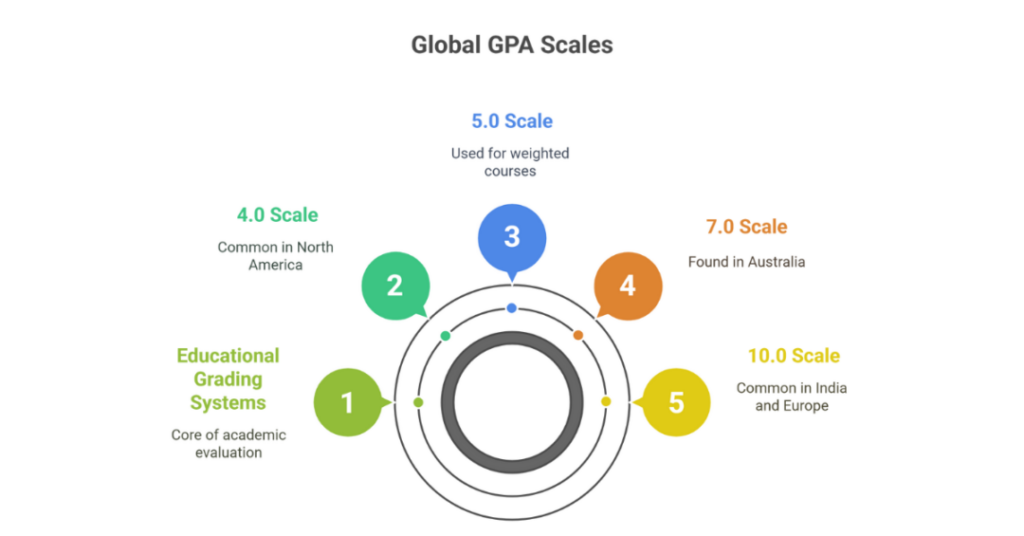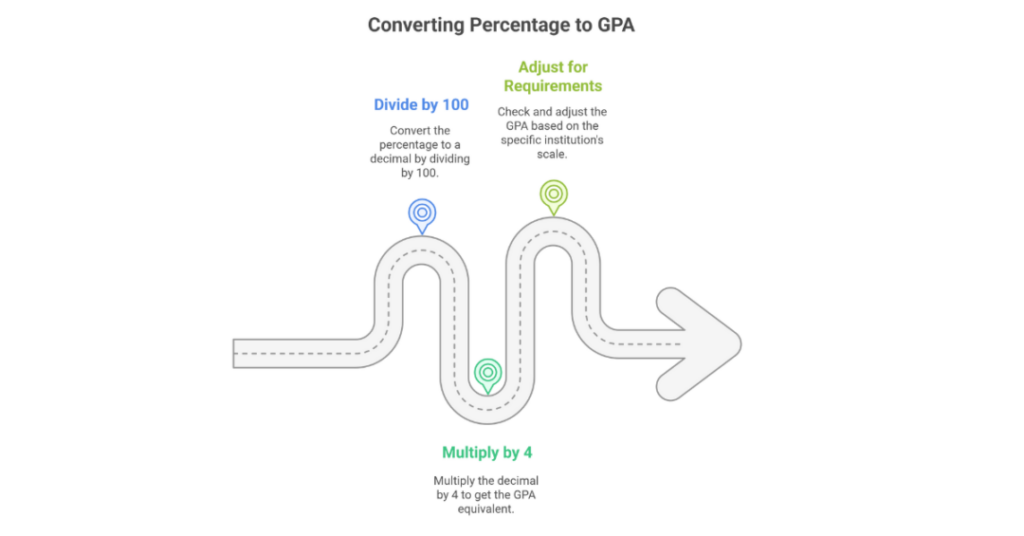28 June 2025
7 minutes read
Understanding the GPA Grading System: A Guide for Indian Students

“Do you know how your academic performance is measured?” The Grade Point Average (GPA) is a vital metric used globally to evaluate students’ achievements. It offers a snapshot of your academic success over time, whether for a single semester or throughout your entire academic journey.
In this engaging guide, we’ll break down the GPA grading system, explaining how it’s calculated, the different types of GPAs, what they mean for students, and share practical tips on boosting your average GPA.
What is a GPA?
A Grade Point Average (GPA) is a numerical representation of a student’s academic performance, reflecting their average grades across all courses. It is typically calculated on a scale ranging from 0.0 to 4.0, with higher numbers indicating better performance.
The GPA is computed by converting letter grades (such as A, B, C) into numerical values and averaging them based on the credit hours of each course. This metric is widely used by educational institutions to evaluate students’ academic achievements, determine eligibility for certain programs, scholarships, and honours, and compare the performance of students across different schools and systems.
What is a good GPA and why is it important?
A good GPA typically ranges from 3.0 to 4.0 on a 4.0 GPA scale, depending on the academic institution and program. It is important because it reflects a student’s consistent academic performance and ability to handle coursework.
A high GPA can open doors to scholarships, honours programs, and competitive academic opportunities. It also plays a crucial role in college admissions, graduate school applications, and even job prospects, as it indicates diligence, intelligence, and a strong work ethic. A good GPA serves as a key indicator of a student’s readiness for advanced education and professional challenges.
Types of GPA’s & their Importance
Knowing the differences between various GPAs is crucial because each provides unique insights into a student’s academic skills. Understanding these distinctions helps accurately assess academic performance, particularly when applying for colleges, scholarships, or jobs that require specific GPA criteria.
Unweighted GPA
The unweighted GPA is calculated on a standard 4.0 scale without considering course difficulty. It is important because it provides a straightforward measure of a student’s overall academic performance, making it easy to compare across different institutions.
Weighted GPA
A weighted GPA accounts for the difficulty of courses, adding extra points for Honours, AP, or IB classes. This type of GPA is crucial for reflecting a student’s ability to excel in more challenging coursework, which can be particularly valuable in competitive college admissions.
Cumulative GPA
The cumulative GPA represents the average of a student’s grades over their entire academic career. It is essential for evaluating overall academic progress and eligibility for graduation, honours, and scholarships.
Major GPA
This GPA focuses on courses within a student’s major. It is important for demonstrating expertise in a specific field, which is often considered by employers and graduate schools.
Types of GPA scales
GPA scales vary globally, reflecting different educational grading systems.

- 4.0 Scale: Common in the United States and Canada, this scale ranges from 0.0 (failing) to 4.0 (excellent), with A=4.0, B=3.0, and so on.
- 5.0 Scale: Used in some U.S. high schools for weighted courses like AP or IB, where an A in these courses can equate to 5.0.
- 7.0 Scale: Found in countries like Australia, where grades range from 0 to 7.0, with 7 being the highest for an HD (High Distinction) grade.
- 10.0 Scale: Common in India and parts of Europe, this scale assigns a score from 0 to 10, with 10 being the highest.
- Percentage Scale: Used in the UK, Australia, and parts of Asia, with grades often represented as percentages; 70-100% generally corresponds to top grades.
- 1.0-5.0 Scale: In Germany, the GPA scale typically ranges from 1.0 to 5.0, where 1.0 signifies excellent performance and 5.0 indicates failure. This scale is inverted compared to others, where lower numbers denote higher grades.
4.0 GPA Scale
The below table provides a standard representation of the 4.0 GPA scale, showing how letter grades correspond to numerical grades and GPA values.
| Letter Grade | Numerical Grade | GPA |
|---|---|---|
| A+ | 97-100 | 4.0 |
| A | 93-96 | 4.0 |
| A- | 90-92 | 3.7 |
| B+ | 87-89 | 3.3 |
| B | 83-86 | 3.0 |
| B- | 80-82 | 2.7 |
| C+ | 77-79 | 2.3 |
| C | 73-76 | 2.0 |
| C- | 70-72 | 1.7 |
| D+ | 67-69 | 1.3 |
| D | 63-66 | 1.0 |
| D- | 60-62 | 0.7 |
| F | Below 60 | 0.0 |
GPA comparisons across countries
Understanding GPA comparisons across countries is crucial for students navigating international education systems, as grading scales and academic standards can differ significantly.
| Indian CGPA (out of 10) | USA (4.0 Scale) | UK (Honours Degree Classification) | Germany (1.0-5.0 Scale) | Australia (7.0 Scale) | Canada (4.0 Scale) |
|---|---|---|---|---|---|
| 9.5 – 10 | 4.0 | 1st Class (70-100%) | 1.0 – 1.5 | 6.5 – 7.0 | 4.0 |
| 8.5 – 9.4 | 3.7 – 4.0 | 2:1 (Upper Second) (60-69%) | 1.6 – 2.0 | 6.0 – 6.4 | 3.7 – 4.0 |
| 7.5 – 8.4 | 3.0 – 3.6 | 2:2 (Lower Second) (50-59%) | 2.1 – 2.5 | 5.0 – 5.9 | 3.0 – 3.6 |
| 6.5 – 7.4 | 2.5 – 2.9 | 3rd Class (40-49%) | 2.6 – 3.0 | 4.0 – 4.9 | 2.5 – 2.9 |
| 5.5 – 6.4 | 2.0 – 2.4 | Pass (Below 40%) | 3.1 – 3.5 | 3.0 – 3.9 | 2.0 – 2.4 |
| Below 5.5 | Below 2.0 | Fail | 3.6 – 5.0 | Below 3.0 | Below 2.0 |
How to you calculate your GPA?
Calculating your average GPA involves a few straightforward steps:
- Assign Grade Points: Convert each letter grade you’ve received into grade points using your institution’s scale (e.g., A=4.0, B=3.0, etc.).
- Multiply by Credit Hours: For each course, multiply the grade points by the number of credit hours the course is worth. This step gives you the quality points for each course.
- Sum the Quality Points: Add up all the quality points from each course.
- Total Credit Hours: Add the total number of credit hours attempted during the term or academic year.
- Divide: Finally, divide the total quality points by the total credit hours. The result is your GPA.
For example, if you took three courses with grades A (4.0), B (3.0), and C (2.0) in courses worth 3, 4, and 3 credits respectively, your GPA would be calculated as follows: (4.03 + 3.04 + 2.0*3) / (3 + 4 + 3) = 27 / 10 = 2.7.
GPA Converter
A GPA converter is a tool or method used to translate academic grades from one grading scale to another. This is particularly useful for students studying in different countries or educational systems, where grading scales may vary significantly.
For example, a GPA converter can help convert grades from a 10.0 scale in India to a 4.0 scale used in the United States. The converter typically takes into account the grading standards of the original and target systems to provide an equivalent GPA. This tool is essential for college admissions, study abroad applications, and understanding academic achievements in a global context.
Percentage to GPA
Just like converting GPA to percentage using a percentage converter in India , you can also convert an Indian percentage to a GPA on a 4.0 scale. Follow the below steps for the conversion.

- Divide the Percentage: Start by dividing your percentage by 100 to get a decimal. For example, if your percentage is 80%, divide 80 by 100 to get 0.80.
- Multiply by 4: Next, multiply the decimal by 4 to convert it to the GPA scale. Using the example, 0.80 multiplied by 4 equals 3.2.
- Adjust for Specific Requirements: Note that different institutions may have specific conversion formulas or scales. Always check the requirements of the educational institution you’re applying to.
This conversion provides an approximate GPA for institutions using a 4.0 scale.
CGPA to GPA
To convert a CGPA (Cumulative Grade Point Average) from a 10.0 scale to a GPA on a 4.0 scale, follow these steps:
- Determine CGPA: Start with your CGPA on a 10.0 scale.
- Use the Conversion Formula: The common formula is: GPA = (CGPA/10) * 4. For example, if your CGPA is 8.5, divide 8.5 by 10 to get 0.85.
- Multiply by 4: Multiply 0.85 by 4 to get 3.4.
- Check Institutional Guidelines: Note that some institutions may use different conversion formulas or additional factors. Always refer to the specific guidelines provided by the institution.
This formula provides an approximate GPA on a 4.0 scale.
4.0 scale to 7.0 scale
To convert a GPA from a 4.0 scale to a 7.0 scale, follow these steps:
- Determine GPA: Start with your GPA on a 4.0 scale.
- Use the Conversion Formula: The common formula is: GPA (7.0 scale) = (GPA (4.0 scale) / 4.0) * 7. For example, if your GPA is 3.5, divide 3.5 by 4.0 to get 0.875.
- Multiply by 7: Multiply 0.875 by 7 to get 6.125.
- Round if Necessary: Some institutions may round the result to the nearest tenth or hundredth.
This formula gives an approximate conversion from a 4.0 GPA scale to a 7.0 scale. Always check with the specific institution for exact conversion methods.
How GPA helps you get Financial Aid?
A strong GPA is often a key factor in securing financial aid, as many scholarships, grants, and merit-based awards require a minimum GPA for eligibility. High academic performance demonstrates a student’s commitment and capability, making them more attractive to scholarship committees and financial aid offices.
Additionally, maintaining a good GPA for bachelor’s degree or any other degree’s can help students retain their financial aid throughout their college career, as many programs require recipients to meet certain academic standards. In summary, a good GPA not only opens doors to financial aid opportunities but also helps sustain them, reducing the financial burden of education.
How to improve your GPA?
Boosting your GPA can open doors to better academic opportunities and scholarships; here are some practical steps to help you improve your grades effectively.
- Attend Classes Regularly: Being present and engaged can help you better understand the material.
- Effective Study Habits: Develop a study schedule, use active learning techniques, and review notes regularly.
- Seek Help: If you’re struggling, get help from teachers, tutors, or study groups early on.
- Prioritize Assignments: Focus on assignments and exams that have a significant impact on your grades.
- Take Challenging Courses Wisely: Enrol in advanced courses where you can excel to boost your weighted GPA.
- Improve Time Management: Plan your time effectively to balance academics, extracurriculars, and rest.
- Participate in Class: Engaging in discussions and asking questions can enhance understanding and improve grades.
Conclusion
Understanding and managing your GPA is crucial for academic success and securing financial aid. Whether you’re navigating different grading scales or aiming to improve your GPA, the strategies outlined can help you achieve your educational goals and enhance your future opportunities. Focus on consistent effort and seek support when needed.
Merge your aspirations with precision using Ambitio’s Shortlist Builder. This tool is designed to bring clarity to your decision-making process, allowing you to create a shortlist that is a true reflection of your highest aspirations.
FAQs
What are the common GPA requirements for honours programs?
Honours programs typically require a minimum GPA, often ranging from 3.5 to 4.0 on a 4.0 scale. Specific requirements vary by institution and program.
How does GPA differ internationally?
GPA scales vary by country and institution. For example, the U.S. commonly uses a 4.0 scale, while Australia uses a 7.0 scale, and Germany uses a 1.0 to 5.0 scale. It’s crucial to understand these differences when applying for international programs.
How does GPA impact college admissions and scholarships?
GPA is a critical factor in college admissions and scholarship decisions. Higher GPAs can increase eligibility for selective programs, honours courses, and merit-based financial aid, demonstrating academic consistency and capability.
What is the difference between weighted and unweighted GPA?
An unweighted GPA does not consider the difficulty of the courses taken, treating all grades equally. A weighted GPA, however, adds extra points for honours, AP, or IB courses, reflecting the increased difficulty of these classes.
What is considered a good GPA?
A good GPA generally ranges from 3.0 to 4.0 on a 4.0 scale, depending on the institution and program. A GPA of 3.5 or higher is often considered excellent and can lead to honours, scholarships, and better job prospects.
How do I convert my GPA to different scales (e.g., 4.0, 5.0, 7.0)?
To convert GPA across different scales, use the formula: (Your GPA / Maximum GPA) * Target GPA Scale. For example, converting a 3.5 GPA on a 4.0 scale to a 7.0 scale: (3.5 / 4.0) * 7.0 = 6.125.

You can study at top universities worldwide!
Get expert tips and tricks to get into top universities with a free expert session.
Book Your Free 30-Minute Session Now! Book a call now




























